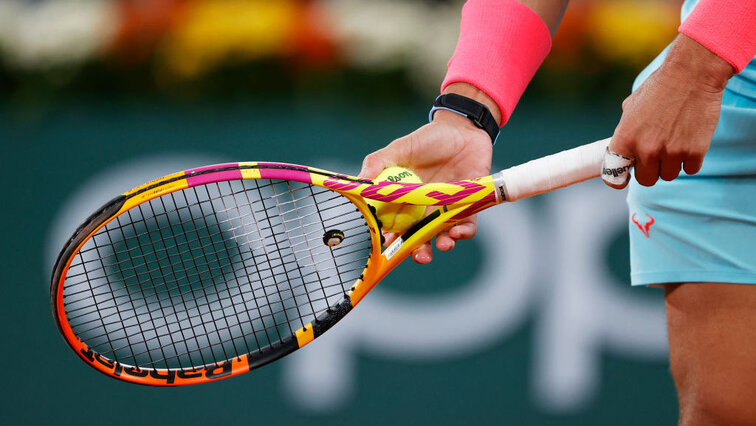The slice serve - as sure as Nadal's title win in Paris
The Slice Serve: A detailed guide that you (probably) haven't read yet. From tennis insider Marco Kühn.
by Marco Kühn
last edit:
Oct 30, 2020, 02:31 pm

The first serve is tried at full speed directly on the line. The second serve flutters fearfully over the edge of the net. In the hope of not being attacked by the enemy. This serve pattern can be seen in many tournaments in the field of hobby players.
But there is one variation that has many advantages, but which is rarely played: the slice serve.
We will gradually uncover all the benefits in this guide. After soaking up this guide, you'll be serving better right away in your next match.
We start with a definition: What is the slice surcharge anyway?
The serve with slice is a variation of your serve. You can serve in different ways:
- Straight
- With kick (forward spin)
- With slice (sideways twist)
And then there is the throw-in ;-) It is usually played right now. If you serve with a slice, you 'cut' the ball on the side when serving. This makes the serve a little slower, but also more toxic. The felt ball turns to the side, flat, away after jumping.
Benefits for left-handers like Nadal
A former coach once told me that left-handers have an almost unfair advantage. With important scores, such as advantage or breakball against you, you can serve with a slice to the outside.
Sure, a right-handed person can do this on the debut side as well. But the scores are not quite as decisive as when serving on the advantage side.
The cut serve is a clever variation that the opponent often does not suit. We will explain in more detail later which advantages the slice surcharge has. In the next step, we'll look at how you can best play the slice serve. Even if you are nervous in a match.
How do you play an effective slice serve?
"Backhand grip, throw the ball a little to the right. Hit the ball on the far right. Imagine that you would just gently stroke the ball." That was the instruction I was taught at the time. Now with these instructions it can happen to you that your slice serve flies directly towards the bank. And that's by no means bad. I am definitely not a fan of technical tips if you've been swinging the racket for more than four or five years. Each player has his own individual processes, grip positions and characteristics. Big changes in these technical details can lead to big problems.
In addition, the textbook is not always right. See Ernests Gulbis' forehand swing a few years ago. You don't have to play the slice serve with a backhand grip. If I've seen it correctly, then Andy Murray plays his (by the way very good) slice serve with a fairly neutral grip. He would probably also tell the opponent too soon what he intends to do if he served this variation with a backhand grip.
Think for yourself, play for you. Find out what works for you. Still, a few ideas will help you get an effective slice serve up quickly. Throwing the ball to the right will help you determine the angle for your slice serve. It can help you if you correct your position a little further outwards when serving. Again, the angle will help you to serve more effectively with a cut.
Test these ideas, and then see how you feel about them. Then adjust and correct until you play a good serve with spin. It's a bit like backing up parking. You have to shunt, keep looking, correct - and then it fits.
We are now looking at what decisive advantages the slice serve can have for you in the course of a close match.
The three decisive advantages of the slice serve
Just think about what causes you more problems with the return:
1) A slow serve played with a lot of cut and on the body, which you also have to go towards
2) A tough board built directly onto your backhand, where you don't have to move an inch and just block
A slice serve through the middle forces your opponent to move sideways. This sideways movement leads to acute timing problems with the return for many amateur players. In addition, the return is often played more with the frame than with the covering.
At this point I don't want to go into the fact that this can also have nervous effects. A slow serve with a cut, simply in the middle, can cause your opponent more problems than a tough first serve. This variation can be a key benefit.
The second nice advantage is that you can serve with more security and a higher rate on the first serve. Since the slice is always played a little slower, the risk is reduced. I like to recommend the slice serve for people with low self-confidence. You can gain important self-confidence through an improved rate on serve. A tennis match is always dynamic. You will always have ups and downs. The shorter you keep the down phases, the more consistently you play tennis.
This brings us to the third key advantage. You can gain confidence for your entire game with a cleverly interspersed slice serve. A quick look at the psychological processes reveals that security when serving always gives the player a good feeling. This good feeling, especially in front of important points, can lead to an improved selection of strokes in a running rally. Every stroke in a rally is nothing more than a decision.
And you will know from your own experience that a decision made on the basis of security is always the better one. I wish you lots of fun and success with your slice serve - and lots of self-confidence.
